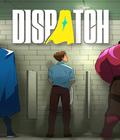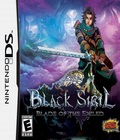Genre: Role-Playing
Publisher: Graffiti Entertainment
Developer: Studio Archcraft
Release Date: June 9, 2009
If you took a look at the video games from my childhood, you'd see none other than classic SNES RPGs like Earthbound, Chrono Trigger and Final Fantasy VI (FF III in the U.S.). It's my guess that the folks over at Archcraft did nothing else but play Chrono Trigger and Final Fantasy VI nonstop for three years and decided to make Black Sigil: Blade of the Exiled for the Nintendo DS, as it borrows heavily from those two titles.
Black Sigil starts off in the snowy land of Bel Lenora. Legend has it that denizens of this area were blessed with the ability to cast magic, with the exception of one person, General Vai, who attacked the land with his evil army of Curse Bringers. The valiant Duke Averay defeated Vai and saved the land. Many years later, he came across a young orphan boy named Kairu and adopted him as a son. Kairu performed excellently at swordsmanship but lacked the ability to use magic. Many grew suspicious of Kairu and believed that he would bring disaster to Bel Lenora, much like Vai had several years before. Kairu is banished to another world along with his half-sister Aurora, who chooses to accompany him. Together, the two must travel across this new land and find their way home.
The story probably isn't the most original, as it consists of parts from several other RPGs from the SNES era, but that kind of adds to the nostalgia factor. Of course, you'll find your archetypal party members ranging from the cool and collected Kairu, the reckless heroine Aurora, the womanizing Nephi, the adamant treasure hunter Rogurd and a few others. A lot of these characters join and leave the party at different points in the story, so you usually have a fresh selection of characters to use. You can have up to three characters in your party at a time, and you can switch out characters at save points and on the world map. Pressing the R shoulder button will allow you to cycle through the lead characters, and some NPCs respond differently to certain characters.
In many ways, Black Sigil plays like the classic RPGs on which it's based. You'll travel from town to town to gain information on your journey and stock up on supplies. You'll explore the world map, caves, forests and other dungeons, where you'll navigate through mazes, collect treasure and battle your way through enemies. The title definitely takes a cue from classic RPGs in one of its most frustrating elements: random battles. The battles appear too often, and it becomes very tedious for those who aren't fans of this system. There are no "shatter effects" to transition the two screens that you would expect from a Final Fantasy type of game; instead, it smoothly fades to black and then fades into the battle screen. Normally when I see a black fadeout screen, I think a cut scene is going to play, but instead I'm greeted with a battle.
Battles are where Black Sigil showcases its resemblance to Chrono Trigger. You have up to three characters participating in battle, and you have to wait for the time bar to fill up before a character can take his turn. For Final Fantasy fans, it's basically the Active Time Battle system. When a character takes a turn, the player has one of four options that appear around the character. These commands can be selected by tapping them with the stylus or holding the d-pad in the direction of the command you want and pressing the A button. Pressing up on the d-pad yields a simple attack; selecting right on the d-pad activates the skill command, which lets you use special attacks or spells; and pressing down on the d-pad lets you use an equipped item (up to four, and you can only equip items on the menu screen outside of battle). Finally, there's the combo command, which is activated by selecting left on the d-pad; if your two characters are ready, you can combine their individual skill moves into a devastating combination. For example, Kairu and Aurora can perform Flamma Thrust, a fiery area of effect attack, while Kairu and Isa can heal all party members with the soothing winds of Averian Curo. Essentially, this is the dual-tech system from Chrono Trigger, which I don't believe has made an appearance in any RPG since then, with the exception of Chrono Cross. It is definitely a welcome addition.
No amount of classic RPG fan service will help you in enduring the game's abundant and sluggish battles, though. The battles aren't as fast-paced as Dragon Quest, nor are they as enjoyable as Final Fantasy; they're just dull. Most of the time, your characters are in the wrong position to attack any enemies, and you'll have to move them by holding down the L button and moving them to where you want them, which is something that you couldn't do in Chrono Trigger.
This adds another element of strategy to battles because you'll be able to avoid enemy area of effect attacks and also be out of range of immobile enemies that can only make melee attacks. Conversely, enemies can also move, which can foil the attack plans that you may have prepared. For instance, at the start of the battle, a group of enemies may appear in a nice cluster and could all be hit with an area of effect attack, but they may move just before your attack is locked in and cause you to miss some of the enemies. It's a bit challenging, but it also grows repetitive, and I prefer to end battles quickly so that I can continue exploring a level — even though I'll just end up in another battle as soon as the previous one ended. I appreciate the homage to classic RPGs, but it would have been better to leave out some of the archaic design elements. I'm not completely against random battles when they're done in moderation like in Lost Odyssey or Dragon Quest, and even then, those battles wrapped up rather quickly. Black Sigil is very traditional and doesn't make much use of the DS' features. The touch-screen is used for selecting commands and features the gameplay, while the top screen displays the status of your characters and a mini-map of the world.
The trend of classic RPG elements extends even to the presentation of the game. The visuals are 16-bit sprites, and the design for the character sprites resembles Chrono Trigger. The environments also share this similarity. The snowy lands of Bel Lenora remind me of Narshe from Final Fantasy VI, while the numerous castles you'll visit beg to be explored, much like Guardia Castle was in Chrono Trigger. While the title doesn't make use of the simplistic actions to express emotions à la Final Fantasy VI, it makes up for it with dialogue that features various character portraits that represent the moods in various situations. A single character could have multiple portraits to represent emotions such as surprise, anger and irritation, as opposed to other games, where there's only one visual representation of a character.
Much like the graphics, the music is also fairly nostalgic and features a quaint MIDI-style soundtrack. You won't find anything here by legendary Final Fantasy composer Nobuo Uematsu, but some of the tracks sound like he could have composed them. The town theme has elements of Secret of Mana and Final Fantasy VI. It's a good thing that the battle theme isn't too bad because you'll hear it quite often. There isn't any voice acting to speak of, so be prepared to read a lot; the back-and-forth banter between Kairu and Aurora is enjoyable.
I found Black Sigil: Blade of the Exiled to be a tribute to the "golden age" of RPGs. Fans of SNES-era RPGs will definitely appreciate the presentation and return of the ATB/Dual-Tech system found in Chrono Trigger. The frequency of random battles, however, really decreases one's enjoyment of the game and changes it into an endurance run of random battles.
Score: 7.0/10More articles about Black Sigil: Blade of the Exiled










 Originally scheduled as a GBA title back in 2006, Black Sigil: Blade of the Exiled is an Active-Time Tactical Combat RPG, featuring the traditional turn-based combat style which requires the player to observe the positions of his or her characters and also the positions of the enemies
Originally scheduled as a GBA title back in 2006, Black Sigil: Blade of the Exiled is an Active-Time Tactical Combat RPG, featuring the traditional turn-based combat style which requires the player to observe the positions of his or her characters and also the positions of the enemies

